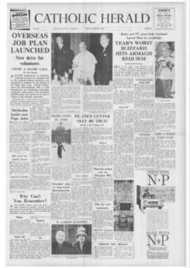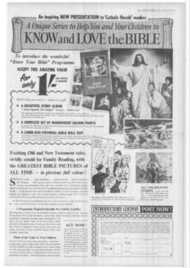Page 4, 8th February 1963
Page 4

Report an error
Noticed an error on this page?If you've noticed an error in this article please click here to report it.
Tags
Share
Related articles
This Was A Vote :: New Style In Niodern C.ologne
Parents Forced To I Vote " Pagan " The Nazi Terro
Whitehall's Reforms Go To Heart Of Dual System
Dr. Downey Fears Attack Oh Catholic Schools
Democracy And Excellence
Church v. State in U.S. school crisis
CATHOLICS in the United States now are confronted with a double dilemma in education:
(1) Unless the Catholic school system is expanded at an accelerated rate, an increasing number of children will grow up as "second class citizens" so far as their religious education is concerned. If such a rapid growth of the Catholic school system is made in order to provide room for all Catholic students, the financial burden would become unbearable.
(2) if a determined drive is made to secure greatly increased local. state and federal government financial aid, there will he the twin risks of generating serious clashes with non-Catholics and of bringing Catholic education under a measure of governmental control.
What the answers are to these hard problems no one knows. From the struggling father of a family to a diocesan superintendent of schools there are only degrees of uncertainty about what can and should be done to preserve and develop the Catholic education system in America.
The Catholic schools are the greatest glory of the Church in the United States. The bulk of the resources in money and manpower have been spent on education since Colonial days. Nowhere else does the Church attempt to educate its youth from kindergarten through the university.
To protect children
In order to protect children and young people from the dangers of a public education system oriented first towards Protestantism and more recently towards paganism, in the 19th Century the Church launched in the United States en education program which continues to be expanded year after year.
Now there the 10,630 Catholic elementary schools and 2,435 Catholic secondary or high schools in the United States. In addition 278 colleges and universities are operated under Catholic auspices. All this has been built out of the savings of the faithful.
Despite the remarkable development of such art extensive system it has not been able to keep up with the demands. At present about one-half of the Catholic children of elementary school age are in Catholic schools and only about one-quarter of those in the high school age. It is difficult to estimate the percentage of Catholic students of college and University age in Catholic institutions. The figure falls somewhere between the elementary and high school percentages, probably in the order of 35 per cent, to 40 per cent.
In recent years problems of Catholic education have been multiplied by the rapid growth in population, by the movement of large numbers of Catholic families from central city parishes to suburban areas. by the tremendous increase in all costs and by a lag in the number of vocations to the religious teaching orders of men and women.
Money and teachers
The Catholic education system in the United States needs money and teachers, both in large numbers. Several billion dollars have been invested in the physical plant. Annual operating costs of maintenance and salaries for teachers amount to hundreds of millions of dollars. Each year new schools are built and teachers must be found not only for such expansion but to fill places which become available through death or retirement.
The financial aspects of the situation are further complicated by creeping inflation which makes almost everything cost a little more in each successive year. Moreover, modern teaching requires more and more expensive equipment, especially in the sciences.
There is no possibility that there will be enough nuns. brothers and priests to staff these schools. Before World War II most teachers in the Catholic system were religious. Apart from the use of lay teachers for athletics. many Catholic elementary schools at one time were staffed 100e; by nuns. It would be unusual to find such a school today. In fact, there are even some Catholic elementary schools staffed 100% by lay teachers. Now there are three nuns for every lay teacher in the elementary schools but by 1970 it is estimated that the ratio will be one to one. In Catholic high schools and colleges there is also a growing number of lay teachers and their academic status and prestige are increasing. At the college and university level there are, of course, more lay teachers than religious.
A lack of balance
Even though Catholic schools pay salaries considerably under scales in public schools, the salary of the lay teacher runs about five times that of a religious. Therefore, the necessary shift to more and more lay teachers • places staggering financial burdens on Catholic schools.
Unfortunately the advantages of of Catholic education are not equally available. Elementary or parish schools have been traditionally the responsibility of each parish. Poor parishes have poor schools or none at all; wealthy parishes usually have good schools.
Catholic high schools are distributed quite irregularly through the 146 archdioceses and dioceses into which the United States is currently divided. In some places the policy of the bishop was to attempt to develop secondary schools to accommodate all Catholic boys and girls: in other places the bishop relied on religious orders to establish high schools able to accommodate only a fraction of the Catholics. While there are some scholarships available, the direct cost toparents of Catholic high school education has certainly been too great for most low income families.
Although there are a number of
excellent Catholic universities and colleges. there arc others which do not provide teaching comparable to that at the better state universities. The ecclesiastical structure of the country and the number of teaching orders have resulted in a proliferation of small colleges. Theoretically at least. a pooling of manpower and financial resources would result in a smaller number of better (and larger) institutions of higher learning.
Need for a new spirit
In order to deal with some of the inequalities in access to Catholic education there is going to have to be developed a spirit of co-operation. Rich dioceses and rich parishes will have to find effective ways of helping poor dioceses and poor parishes. The idea of the parochial school depending on one parish for managment and money might have to give way to diocesan direction and financing.
Humanly speakine. it would seem that the goals of universal Catholic education in the United States cannot be achieved. For this reason some educators have urged that a certain sector of the Catholic school system he dropped so that money and manpower may be concentrated on the other sectors.
The basic difficulty with this approach is that there is complete disunity concerning what sector is "expendable". Some suggests dropping the lower elementary grades; others the higher elementary. Still others suggest discontinuing high schools; others think a mistake was made in establishing a large number Catholic colleges and universities rather than strong Newman Clubs or residences with priest counsellors at state universities.
It is likely that there never will be any general decision to drop any part of the Catholic educational system throughout the United States. It is. however. probable that there will he increasing experiments locally conducted to find out the practical effects of the various suggestions.
Prudence needed
Up to now Catholic schools share in public school funds—local, state or federal—only in a minor degree. Subsidized milk is available in many places. In some areas Catholics are provided with bus transportation and school nurses.
Many feel that the Catholic child as a citizen is entitled to the full measure of governmental aid provided other children. There is great concern at present that any new program of federal aid to education will be set up in a fashion which discriminates against the Catholic student.
It is on this question that President John F. Kennedy and many of his co-religionists differ. The President is on record as asserting that federal aid on the elementary and high school levels is unconstitutional. He favours some form of federal aid to religious colleges and universities. It is hard to understand how the age of the benefiting student can affect the constitutionality of the grant.
Tn many parts of the U.S. Catholics are becoming increasingly militant on educational matters, Approximately half of their local taxes go to public schools and they are taking sharp looks not only at fiscal policy but education policy. This attention by "outsiders" is resented in many communities. Here are seeds of controversy because both the pocketbook and emotions are involved.
For the foreseeable future Catholics in the United States will need prudence, tact and good humour in their dealings on local. state and federal educational issues. Moreover. they also will need to be blessed with a good measure of material wealth in order to maintam a Catholic educational system which can do a good job in helping to make good citizens and saints.
blog comments powered by Disqus











